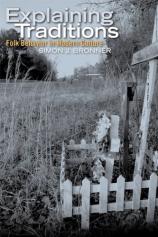Explaining Traditions: Folk Behavior in Modern Culture
Review
Explaining Traditions: Folk Behavior in Modern Culture
“Every day people are involved in events they recognize as traditional, and at the same time they look to establish precedents for traditions of the future. They do so because tradition fuels their culture.”
"EXPLAINING TRADITIONS opens our eyes to why we reject some aspects of tradition, why we choose to keep the lore we keep, and the ways in which we are haunted by collective memory."
EXPLAINING TRADITIONS is a thought-provoking book about what constitutes tradition, why we continue to care about traditions, and how we forge new ones. Author Simon Bronner is a Distinguished University Professor of American Studies and Folklore at Pennsylvania State University and has written other books relating to folk customs. He points out that, for many people, the word “tradition” is negatively loaded, associated with burdens from the past that can unfairly weigh our perceptions of what is possible. Yet even those who seek to avoid tradition are nearly always carriers of some remnant of it, because folk culture is inculcated at the earliest age.
For example, nursery rhymes and rhyming games, such as for jump roping, are full of hidden meanings. Through the passage of time, these “simple” ditties have become part of a learning process, introducing adult ideas to children’s minds. I had not fully considered until reading Bronner that there were adult themes running through these childish verses. One that comes to mind is a song I used to sing that contained these words: “He gave me all his peaches, he gave me all his pears, he gave me all his fifty cents and kissed me on the stairs.” Bronner states that “going upstairs” is a sexual reference, and thus the song would be about getting money for sex. Luckily for the girl in my rhyme, she goes on to say, “I didn’t want his peaches, I didn’t want his pears, I didn’t want his fifty cents and kicked him down the stairs.” If she had consumed his offerings, she might have gotten a bellyache, a code for pregnancy. I have no memory of when or how I learned this song, which is probably typical of traditions. They are absorbed without thought. We grow up certain that the number 13 is unlucky, that a full moon is an omen of madness, and that a four-leaf clover brings good luck.
Bronner spent time listening to and recording folk storytellers, mostly African American males whose stories involve men besting one another, often in violent circumstances, and women who are less than virtuous. Good storytellers have a way of captivating their audience; someone who has this art will become well known in his culture, including the culture of prison. As Bronner says of one of his interviewees, “His folklore informed others how he wanted to be treated and what the consequences would be if they failed to treat him correctly.” Probably most of us, if we examined the jokes and stories that have stayed with us over the years, would see our own patterns of protection and perception in the kinds of tales we favor.
The book contains analyses of such phenomena as roadside shrines, American football rituals, lost languages and death rituals. It winds up with an examination of the now fully blown culture of the Internet, including the comparison of computers with toilets (garbage in, garbage out!) and this memorable quip, “Oh what a tangled Web we weave when first we practice.”
EXPLAINING TRADITIONS opens our eyes to why we reject some aspects of tradition, why we choose to keep the lore we keep, and the ways in which we are haunted by collective memory, even as we seek to slough off its vestiges.
Reviewed by Barbara Bamberger Scott on December 1, 2011
Explaining Traditions: Folk Behavior in Modern Culture
- Publication Date: July 22, 2011
- Genres: Nonfiction, Social Sciences, Sociology
- Hardcover: 544 pages
- Publisher: The University Press of Kentucky
- ISBN-10: 0813134064
- ISBN-13: 9780813134062




